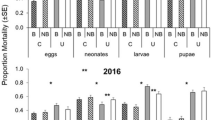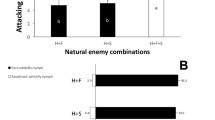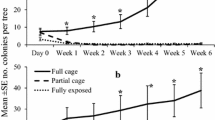Abstract
Release of approximately 17,700 experienced adult femaleEdovum puttleri Grissell against 1st generation Colorado potato beetle eggs in 1987 in a 0.4 ha potato field in S. Deerfield, Massachusetts resulted in only 3.6% parasitism as assessed by direct measurement of host and parasitoid recruitment. Levels of non-viability indicated an additional 2.8% of hosts killed by parasitoid hostfeeding, for an overall impact of 6.4%. Release in 1988 of 126,300 parasitoid against 1st generation hosts in a 0.4 ha potato (Solanum tuberosum L.) field at the same site produced only slightly higher levels of parasitism (10.6%) and host feeding (2.0%).
Release in 1987 of 32,800 wasps against 2nd generation eggs resulted in only 0.7% parasitism and 0.3% host feeding due to the toxicity of fenvalerate (PydrinR) residues from a single application applied for control of the potato leafhopper,Empoasca fabae (Harris). Release in 1988 of 47,400 wasps against the 2nd host generation in the absence of any pesticide applications resulted in 34.4% parasitism and 16.1% host feeding, for a total impact of 50.5%. Difference in parasitization levels between host generations supports the idea thatE. puttleri adults require an in-field carbohydrate source such as aphid honeydew to reproduce. In Massachusetts, aphid populations in potato typically do not develop until the end of the 1st larval generation.
The recruitment method ofVan Driesche & Bellows (1988) proved to be a satisfactory approach for determining results of augmentative parasitoid releases.
Résumé
En 1987, le lâcher approximatif de 17.700 adultes deE. puttleri femelles, contre la première génération des œufs de doryphores dans un champ de pommes de terre à S. Deerfield au Massachusetts, entraînait un parasitisme, établi par la mesure directe de l'hôte et du parasitoïde, de 3.6% uniquement. Les niveaux de non viabilité indiquaient un pourcentage supplémentaire de 2,8% d'hôtes tués par «host-feeding» pour un impact total de 6,4%. Le lâcher en 1988 de 126.300 parasitoïdes contre la 1re génération d'hôtes dans un champs de pommes de terre de 0,4 ha au même endroit, produisait uniquement des niveaux légèrement supérieurs de parasitisme (10,6%) et d'«host-feeding» (2,0%).
Le lâcher en 1987 de 32.800 hyménoptères contre la 2e génération d'œufs entraînait uniquement 0,7% de parasitisme et 0,3% d'«host-feeding» par suite de la toxicité des résidus d'une seule application de fenvalerate (PydrinR) utilisée pour lutter contre la cicadelle de la pomme de terreEmpoasca fabae (Harris). Le lâcher en 1988 de 47.400 hyménoptères contre la 2e génération d'hôtes entraînait, en l'absence de toute application insecticide, 34,4 % de parasitisme et 16,1 % d'«host-feeding» pour un impact total de 50,5%. La différence dans les niveaux de parasitisme entre les générations de l'hôte supporte l'idée que les adultes d'E. puttleri réclament à l'extérieur une source d'hydrates de carbone tels que le miellat de pucerons pour se reproduire. Dans l'Etat du Massachusetts, les populations de pucerons de la pomme de terre, ne se développent typiquement pas jusqu'à la fin de la première génération larvaire.
La méthode «de recrutementα deVan Driesche & Bellow (1988) pouvait être une approche satisfaisante pour déterminer les résultats de lâchers croissants de parasitoïdes.
Similar content being viewed by others
References
Ferro, D. N., Logan, J. A., Voss, R. H. &Elkinton, J. S.—1985. Colorado potato beetle [Coleoptera: Chrysomelidae] temperature-dependent growth and feeding rates.—Environ. Entomol., 14, 343–348.
Harcourt, D. G.—1971. Population dynamics ofLeptinotarsa decemlineata (Say) in eastern Ontario. III. Major population processes.—Can. Entomol., 103, 1049–1061.
Idoine, K.—1989. Aspects of the behavioral ecology ofEdovum puttleri.—Masters Thesis, Univ. of Massachusetts, Amherst, MA.
Idoine, K. &Ferro, D. N.—1988. Aphid honeydew as a carbohydrate source forEdovum puttleri [Hymenoptera: Eulophidae].—Environ. Entomol., 17, 941–944.
Idoine, K. &Ferro, D. N.—1990. Diurnal timing of ovipositional activities ofEdovum puttleri Grissell [Hymenoptera: Eulophidae], an egg parasitoid of Colorado potato beetle,Leptinotarsa decemlineata (Say) [Coleoptera: Chrysomelidae].—Environ. Entomol., 19: 104–107.
Lashomb, J., Ng, Y. S., Janson, R. K. &Bullock, R.—1987.Edovum puttleri [Hymenoptera: Eulophidae], an egg parasitoid of Colorado potato beetle [Coleoptera: Chrysomelidae]: development and parasitism on eggplant.—J. Econ. Entomol., 80, 65–68.
Pucci, C. &Dominici, M.—1988. Field evaluation ofEdovum puttleri Grissell [Hym.: Eulophidae] on eggs ofLeptinotarsa decemlineata (Say) [Col.: Chrysomelidae] in central Italy.—J. Appl. Entomol., 106, 465–472.
Schroder, R.F.W. & Athanas, M. M.—1985. Review of research onEdovum puttleri Grissell, an egg parasite of the Colorado potato beetle. In: Proceedings of the Symposium on the Colorado Potato Beetle, XVIIth International Congress of Entomology (D. N. Ferro & R. H. Voss, eds.).—Mass. Agric. Expt. Stn. Res. Bull., 704, 29–32.
Schroder, R. F. W. &Athanas, M. M.—1989. Use of the egg parasiteEdovum puttleri [Hym.: Eulophidae] in an IPM system developed for Colorado potato beetle[Col.: Chrysomelidae] control on potatoes, Beltsville, Maryland.—Entomophaga, 34, 193–199.
Sears, M. K. &Boiteau, G.—1989. Parasitism of Colorado potato beetle [Coleoptera: Chrysomelidae] eggs byEdovum puttleri [Hym.: Eulophidae] on potato in earstern Canada.—J. Environ. Entomol., 82, 803–810.
Van Driesche, R. G.—1983. The meaning of “percent parasitism” in studies of insect parasitoids.—Environ. Entomol., 12, 1611–1622.
Van Driesche, R. G. &Bellows, T. S. Jr.—1988. Host and parasitoid recruitment for quantifying losses from parasitism, with reference toPieris rapae andCotesia glomerata.—Ecol. Entomol., 13, 215–222.
Van Driesche, R. G., Bellows, T. S. Jr., Ferro, D. N., Hazzard, R. &Maher, A. —1989. Estimating stage survival from recruitment and density data, with reference to egg mortality in the Colorado potato beetle,Leptinotarsa decemlineata (Say) [Coleoptera: Chrysomelidae].—Can. Entomol., 121, 291–300.
Author information
Authors and Affiliations
Rights and permissions
About this article
Cite this article
Van Driesche, R.G., Ferro, D.N., Carey, E. et al. Assessing augmentative releases of parasitoids using the «Recruitment method», with reference toEdovum puttleri, a parasitoid of the colorado potato beetle [Coleoptera: chrysomelidae]. Entomophaga 36, 193–204 (1991). https://doi.org/10.1007/BF02374555
Received:
Accepted:
Issue Date:
DOI: https://doi.org/10.1007/BF02374555
Key-words
- parasitoids
- recruitment
- evaluation
- Edovum puttleri
- Leptinotarsa decemlineata
- potato
- biological control
- augmentation




